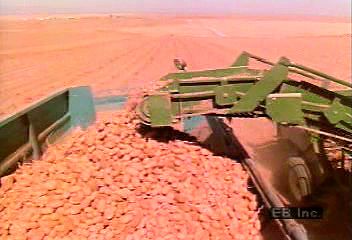Study potato farming practices in Idaho from crop planting to harvest and storage

Study potato farming practices in Idaho from crop planting to harvest and storage
Potato harvesting in the Snake River valley, Idaho.
Encyclopædia Britannica, Inc.
Transcript
NARRATOR: This is one of many storehouses in the Snake River valley in Idaho. Every year, in September and October, buildings like this one are filled from floor to ceiling with the state's most-famous crop, potatoes.
The hot days and cool nights of this area help to grow millions of the very best potatoes. In fact, Idaho is the United States' largest producer of potatoes. Planted in early April, the potatoes are ready for harvest around six months later, in the middle of September.
The potatoes grow under the sandy soil. A crossover machine digs them up and lays them down in rows for the combine to collect.
The combine goes down the rows picking up the potatoes, separating them from the dirt and most of the stalks. The potatoes must be taken out of the ground before the first frost, or they will be ruined.
Once the trucks are filled, they are driven from the fields to the storage buildings, called cellars or potato pits.
The potatoes are dropped off on a collector and are sorted according to size. The smaller ones are called seed potatoes; they will be cleaned and dried, stored, and used to plant some of the following year's crop.
The rest of the potatoes goes to the cellars. Each cellar holds about seven million pounds of potatoes.
With the cellars full, the farmers' work is mostly done. The potatoes are stored for nine months, in the dark and at cool temperatures. They will then be sent to stores, food-processing plants, and restaurants throughout the United States.
The hot days and cool nights of this area help to grow millions of the very best potatoes. In fact, Idaho is the United States' largest producer of potatoes. Planted in early April, the potatoes are ready for harvest around six months later, in the middle of September.
The potatoes grow under the sandy soil. A crossover machine digs them up and lays them down in rows for the combine to collect.
The combine goes down the rows picking up the potatoes, separating them from the dirt and most of the stalks. The potatoes must be taken out of the ground before the first frost, or they will be ruined.
Once the trucks are filled, they are driven from the fields to the storage buildings, called cellars or potato pits.
The potatoes are dropped off on a collector and are sorted according to size. The smaller ones are called seed potatoes; they will be cleaned and dried, stored, and used to plant some of the following year's crop.
The rest of the potatoes goes to the cellars. Each cellar holds about seven million pounds of potatoes.
With the cellars full, the farmers' work is mostly done. The potatoes are stored for nine months, in the dark and at cool temperatures. They will then be sent to stores, food-processing plants, and restaurants throughout the United States.









